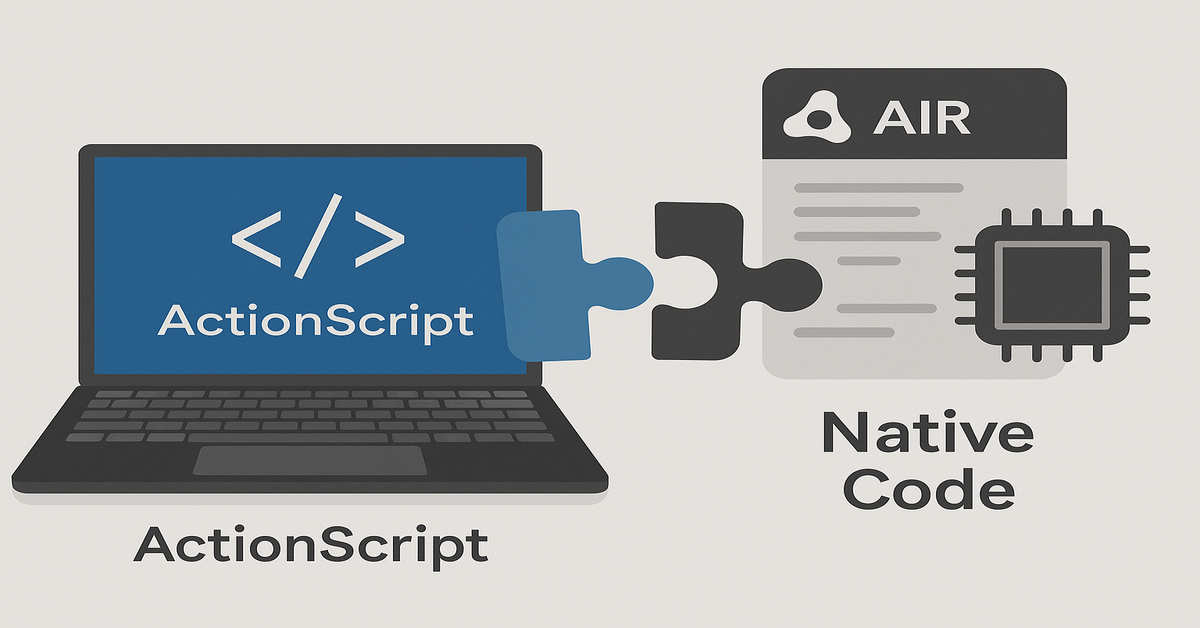
In the field of cross-platform app development, achieving both flexibility and high performance is a common challenge. Adobe AIR (Adobe Integrated Runtime) has long been a tool that enables developers to create applications for multiple platforms using familiar technologies such as ActionScript and Adobe Flash. However, AIR applications are often limited to what the runtime itself supports. Developers may need access to device-specific features or low-level APIs that are not directly available in the default AIR environment. This is where AIR Native Extensions (ANE) come into play.
AIR Native Extensions, often abbreviated as ANEs, bridge the gap between the managed ActionScript environment and the device’s native code capabilities. They allow developers to extend the functionality of AIR applications by integrating native features written in languages such as Java (for Android), Objective-C or Swift (for iOS), and C/C++ (for Windows and macOS).
This article provides an in-depth exploration of AIR Native Extensions, including their definition, importance, internal structure, practical use cases, benefits, risks, and how developers can create and integrate them. By the end, you’ll understand not only what ANEs are but also why they remain relevant and powerful in modern cross-platform development.
What is an AIR Native Extension?
An AIR Native Extension (ANE) is essentially a packaged module that allows an Adobe AIR application to access features and functionality not available through the default AIR APIs. It acts as a connector between ActionScript code and platform-specific native code.
In simple terms:
- AIR provides the cross-platform shell.
- ANE provides access to native APIs.
- Developers write ActionScript to call functions within the ANE.
This makes ANEs crucial when an app requires features like biometric authentication, advanced file handling, push notifications, sensors, or hardware-accelerated graphics that aren’t exposed by AIR directly.
Why AIR Native Extensions Are Important
Without ANEs, AIR developers would be limited to only what Adobe AIR provides out of the box. That would exclude many modern features essential to building competitive applications.
Here’s why ANEs matter:
- Access to Native Features – Developers can tap into GPS, accelerometer, camera APIs, or Bluetooth connectivity.
- Cross-Platform Development – Instead of writing multiple apps for different platforms, AIR developers can leverage ANEs for platform-specific functionality while still coding the main application once.
- Performance Enhancements – Critical operations can be offloaded to efficient native code, improving speed.
- Longevity of AIR Applications – Even as AIR evolves, ANEs allow apps to keep up with new OS features.
The Structure of an AIR Native Extension
An AIR Native Extension package consists of several components that work together to enable communication between ActionScript and native code.
| Component | Description |
|---|---|
| ActionScript Library (SWC) | The part exposed to the AIR app; defines the API developers use. |
| Native Code (DLL, JAR, .framework, etc.) | Contains the actual implementation in platform-specific code. |
| Extension.xml File | Describes the extension, its supported platforms, and metadata. |
| Platform Binaries | Separate builds for Android, iOS, Windows, or macOS. |
| Packaging | Everything is bundled into a single .ane file that the AIR runtime can load. |
This modular design makes it possible for one ANE to support multiple platforms with different implementations behind the same ActionScript interface.
How AIR Native Extensions Work
- Developer calls a function in ActionScript – Example:
myExtension.startGPS(). - AIR runtime looks into the ANE – The request is directed to the extension.xml and linked native library.
- Native function executes – Written in Java, C++, or Objective-C depending on the platform.
- Result returns to ActionScript – The AIR app receives data as if it were an internal function.
This flow allows a seamless bridge between high-level ActionScript code and the raw power of native device features.
Building an AIR Native Extension
Creating an ANE requires multiple steps and knowledge of both ActionScript and native languages.
Step 1: Define the Extension
- Write the extension.xml to specify name, version, and supported platforms.
Step 2: Create the ActionScript API
- Write a library in ActionScript (usually compiled as a
.swc) that defines the methods exposed to developers.
Step 3: Implement Native Code
- Write the platform-specific code in the native language (Java for Android, Objective-C/Swift for iOS, C++/C# for desktop).
Step 4: Bridge Communication
- Use the Adobe AIR Extension API to connect ActionScript calls to native functions.
Step 5: Package the ANE
- Combine the SWC, binaries, and XML file into a
.anepackage.
Step 6: Integrate into App
- Developers include the
.anefile in their project and call the new functionality directly from ActionScript.
Example Use Cases of ANEs
AIR Native Extensions are useful for bridging gaps between platform capabilities and cross-platform development.
| Use Case | Native Feature Accessed | Benefit |
|---|---|---|
| Push Notifications | iOS APNS, Android FCM | Real-time communication with users |
| In-App Purchases | App Store, Google Play Billing | Monetization options |
| Camera Access | Device cameras and filters | Advanced photo/video apps |
| Bluetooth | Low Energy (BLE) APIs | Fitness trackers, IoT devices |
| Biometric Authentication | Touch ID, Face ID, Android Biometrics | Secure app login |
| File System | Native file APIs | More control than AIR provides |
| Analytics | Integration with native SDKs | Track user behavior |
Benefits of AIR Native Extensions
- Flexibility – Developers can add any missing feature not included in AIR.
- Reusability – ANEs can be packaged and reused across multiple apps.
- Community Support – A marketplace of ANEs exists, both free and commercial.
- Time Savings – Instead of rewriting an app for each platform, developers maintain one core app and supplement with ANEs.
- Competitive Edge – Apps can compete with native applications by having nearly identical functionality.
Challenges and Limitations
While ANEs provide many benefits, they also introduce challenges.
- Learning Curve – Developers must know multiple languages and platforms.
- Complex Debugging – Errors in native code can be harder to trace.
- Platform Fragmentation – Maintaining separate codebases for iOS, Android, and desktop can be resource-intensive.
- Dependency Risks – If an ANE is provided by a third party, updates may lag behind OS changes.
- Performance Overheads – Poorly optimized ANEs can slow down applications.
Example Workflow in Action
Imagine a developer wants to add fingerprint authentication to their AIR app:
- Write an ActionScript method:
myAuth.authenticateWithFingerprint(); - Create an ANE with iOS code using Touch ID and Android code using biometric APIs.
- Package it into
.ane. - Import
.aneinto the project. - Deploy the AIR app.
Now the AIR app can perform fingerprint-based authentication natively on both platforms with a single ActionScript call.
The Future of AIR Native Extensions
Even though AIR is no longer in the mainstream spotlight, it is still maintained and used in niche markets such as enterprise applications, kiosks, games, and educational software. ANEs remain critical for these applications to keep pace with modern features.
Trends shaping the future:
- Increased reliance on ANEs as new hardware features appear (AR, VR, wearables).
- Community-driven development since Adobe handed AIR over to Harman for future support.
- Hybrid app growth means tools like ANEs are still relevant for bridging gaps.
Lessons for Developers
- Plan Ahead – Know which features require ANEs before starting development.
- Keep it Modular – Separate ActionScript code from native logic to make updates easier.
- Test Extensively – Different devices may behave differently with the same ANE.
- Stay Updated – Monitor OS updates that might break native code.
- Balance Use – Only use ANEs where truly necessary; avoid overloading apps with extensions.
Comparison: ANE vs. Alternative Approaches
| Approach | Pros | Cons |
|---|---|---|
| ANE | Direct native feature access, reusable, fast | Requires native coding, complex debugging |
| Pure AIR | Simple, cross-platform | Limited feature set |
| Hybrid Frameworks (Flutter, React Native) | Broad community, built-in plugins | Requires migrating app, new learning curve |
This comparison shows why ANEs continue to be valuable for existing AIR projects.
Conclusion
AIR Native Extensions represent one of the most powerful features available to developers working within the Adobe AIR ecosystem. They serve as a bridge between the flexibility of cross-platform ActionScript code and the full power of native device APIs. While they require additional effort to build and maintain, the result is applications that are more capable, competitive, and user-friendly.
By understanding their structure, workflow, benefits, and limitations, developers can make informed decisions about when and how to integrate ANEs into their projects. In a world where app functionality increasingly depends on native features, ANEs ensure AIR remains relevant, adaptable, and future-ready.
FAQs
1. What is the purpose of an AIR Native Extension?
It allows Adobe AIR applications to access native device features unavailable through default AIR APIs, such as sensors or biometric authentication.
2. Do I need to know native programming to create an ANE?
Yes. Creating ANEs requires knowledge of ActionScript as well as native languages like Java, Objective-C, or C++.
3. Can one ANE work on multiple platforms?
Yes. An ANE can include separate native implementations for Android, iOS, and desktop, all packaged under one interface.
4. Are there ready-made ANEs available?
Yes. Many commercial and free ANEs exist, offering features like push notifications, in-app billing, or analytics.
5. Is AIR still supported today?
Yes. Adobe transferred AIR’s development to Harman, and it continues to be supported, especially in enterprise and niche use cases.






